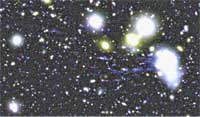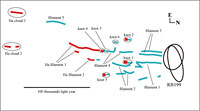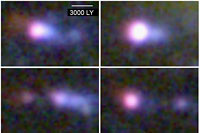Press Release
Galaxy Ramming Through Space Creates Fireballs
October 6, 2008
 Galaxies evolve over time by changing shape, size, and color. Understanding the evolutionary processes of galaxies is one of the most important issues in astronomy for which there are still fundamental problems to be solved. One straightforward approach is to study clusters of galaxies that contain several thousands to tens of thousands of galaxies. Galaxy Clusters are dense populations of galaxies, rich with hot intergalactic gas, accompanied by strong gravitational forces. These clusters are the best location to observe environmental effects in galactic evolution.
Galaxies evolve over time by changing shape, size, and color. Understanding the evolutionary processes of galaxies is one of the most important issues in astronomy for which there are still fundamental problems to be solved. One straightforward approach is to study clusters of galaxies that contain several thousands to tens of thousands of galaxies. Galaxy Clusters are dense populations of galaxies, rich with hot intergalactic gas, accompanied by strong gravitational forces. These clusters are the best location to observe environmental effects in galactic evolution.
To resolve the effect of the environment on the evolution of galaxies, a team of researchers from the National Astronomical Observatory of Japan and the University of Tokyo used Suprime-cam on the Subaru Telescope to observe the Coma Cluster of galaxies. The Coma Cluster contains over 1,000 galaxies and is fairly close to Earth at about 300 million light years away. The central portion of the Cluster is inhabited by mostly elliptical galaxies, both dwarf as well as giants.
During observations in 2006 and 2007, it was by chance that the astronomers discovered a thread-like structure stretching from one of the galaxies. This filament, extending from Galaxy RB199 for about 260 thousand light years, becomes bluer the greater distance from the galaxy, suggesting a younger age toward the outer edge of the filament. The filament also has many young stars surrounded by ionized gas that look like projectiles flying out from the galaxy; the research team called these knots “fireballs”. Detailed study identified several bright knots connected by blue filamentary structures, and the knots are actually the clusters of young stars weighing 10 million times our Sun and contained in an area about 3000 to 6000 light years across. Because the knots are accompanied by ionized gas, active star formation is going on in the fireballs where usually far less star formation would be expected. The team noted that the size and the mass of the fireballs indicate they could develop into dwarf galaxies.
A question that developed during the study was what mechanism(s) stripped gas from Galaxy RB199 and created the fireballs? Because the inside of the cluster is crowded with galaxies, they pass by each other and crash into each other. The team thought that the tidal forces during such encounters could strip gas or stars from the galaxies. They also postulated that as a galaxy falls into the center of the cluster the gravitational forces of the cluster could remove the gas and stars from that galaxy. Both scenarios are possible, however, the research team found that these mechanisms could hardly explain the characteristics of the fireballs. The team then realized that ram pressure stripping occurs when superheated gas (several tens of million Kelvin) in the cluster and the galaxies collide at high speeds. Previous X-ray observation shows the presence of large amounts of hot ionized gas in the middle of the Coma Cluster while RB199 crashes into the center at a speed of 1200 miles per second, causing strong friction with this hot gas. As such, the team concluded that the ram pressure has enough power to strip the gas from the galaxy AND create the fireballs.
While there are several reports indicating ram pressure stripping in nearby galaxy clusters, the identification of fireballs in this study is the first to demonstrate the stripped gas turns into stars while traveling through remote space far away from its source. Similar phenomena have been observed in galaxy clusters much further away at several billions light years, however, those distant cases were interpreted through witnessing the transitional phase of galaxies changing their morphology or colors as they fall into a cluster. The fireballs discovered by this team of Japanese astronomers provide the first sample of such structures in a nearby cluster. Principal investigator, Dr. Michitoshi Yoshida, said “the team is confident that our study of these phenomena leads to a better understanding of the gas stripping processes in galaxy clusters, and the effect of clusters on the evolution of individual galaxies”.
The findings from this pioneering study will be published in the 10 December 2008 issue of the Astrophysical Journal (Volume 689, Issue 1). This research team has discovered other varieties of gas stripping phenomena toward the Virgo Cluster (Discovery of Huge Gas Cloud Expanding around Galaxy) as well as the Coma Cluster (Unusual Streak of Ionized Gas Hints at Galaxy's Past). Further details about this team’s research results, other astronomical studies, and the state-of-the art technologies at the Subaru Telescope can be found within our website.
Strange Filamentary Structures ("Fireballs") around a Merger Galaxy in the Coma Cluster of Galaxies Yoshida, M., Yagi, M., Komiyama, Y., Furusawa, H., Kashikawa, N.,Koyama, Y., Yamanoi, H., Hattori, T. and Okamura, S., 2008, The Astrophysical Journal, Volume 689, Issue 1
Note 1: Ionization occurs when sufficient energy is given to an atom, and then the electrons are released from the atom. The gaseous cloud that consists of these ionized atoms - ions - and the electrons is called ionized gas or plasma. One of the mechanisms to ionize the interstellar gas is the strong ultraviolet radiation from the young massive stars just born. Active star formation site accompanies large-scale ionized gas and can be observed as the strong source of ionized hydrogen.
Note 2: Dwarf galaxies are small galaxies with luminosities less than 10% of the Milky Way galaxy. The nearby clusters of galaxies such as the Coma Cluster have extremely large numbers of faint dwarf galaxies. The origin of those numerous dwarf galaxies is yet to be known.
 |
